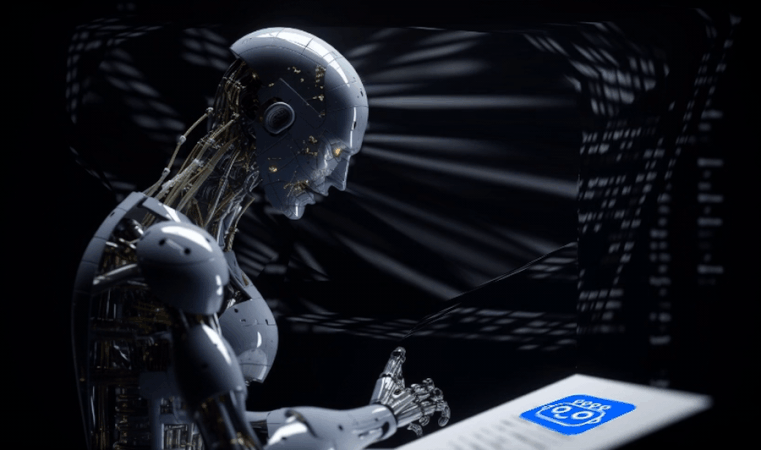“Got a real head-scratcher like ‘How do AI writing detectors work?’ buzzing in your mind? You’re not alone!
In today’s world, the written content biz is grappling with a monster of a problem, with AI playing a starring role in the drama.

Try these new AI-powered tools:
- 5 Best AI Detectors To Unmask AI-Written Content With Accuracy
- 5 Best AI Writers To Boost Your Productivity And Content Quality.
- This "Secret AI Writer" Can Bypass AI Detection Like A Pro.
With the wonders of Artificial Intelligence (AI) tech, it’s a breeze for the crafty lot to cook up and spread phony content. The stuff churned out by AI writing tools is so finely spun, it takes a real pro to sniff out the fishiness.
But worry not, that’s where our superstars, the AI writing detectors, enter the scene! If you believe your AI-scripted content is undetectable, think twice.
In this piece, we’re gonna take you on a deep dive into the world of AI writing detectors, and how they keep your work original and true-blue. We’ve done our homework on the various tactics these gizmos use, their weak spots, and how they’re getting better at their game.
Whether you’re a teacher striving to keep things honest in academia or a business boss shielding your brand from rip-offs, getting an understanding of AI writing detection will set you up with the right gadget for your mission!
Article At-A-Glance
-
- AI writing detectors are smart cookies, with their tricky algorithms and detailed text checks. They’re pros at spotting the tell-tale signs of machine talk, making them solid bets for telling apart human-created and AI-generated content.
- Picking out AI-created stuff is a biggie for maintaining the uprightness and realness of written work, and our AI writing detectors are up to the task.
- To keep content legit, detectors use fancy techniques like checking language trends, word use, sentence length, and grammar. This lets them tell apart the stuff written by us folks from the ones spat out by machines.
- Thanks to constant work in research and development, these AI writing sniffer dogs are getting better and better at their job. They’re learning to spot more subtle signs of machine-made text, and they’re also learning to play nice with other tools, boosting their efficiency and dependability.
Make AI Writing Undetectable In 15 Seconds: Learn More »
Table Of Contents
What’s AI Writing Detection About?
AI writing detection is all about catching machine-created content by its language patterns, comparing it with known machine-made stuff, and looking out for dodgy features.
Getting why AI writing detection matters helps you dish out quality content that can’t be disputed.
Why’s AI-Writing Detection A Big Deal?
With more AI-created content popping up all over, AI writing detection is becoming a bigger deal by the day in our digital world.
It’s increasingly crucial to spot and stop any sneaky manipulation attempts using AI.
AI text detectors are a handy solution for folks and companies alike to identify AI-created content, keeping their stuff honest and real.
Through checking language trends, sentence structures, word use, grammar goofs, and how smoothly the text flows, the smart algorithms of AI detection software can call out if a piece of writing is human-made or machine-made.
This ensures you’re getting your news from trustworthy sources, steering clear of possibly twisted media tales. Imagine if you’ve been reading stuff from an AI-created site – that’s a recipe for disaster if you’re after reliable info.
Plus, AI tech also helps bust plagiarists online, making sure the content that’s out there is clean as a whistle.
It also keeps writers’ intellectual property safe from crooks looking to swipe and misuse their work. So, that’s a big thumbs up!
How Accurate Are AI Writing Detectors?
Let’s get real here. AI writing detection is popping up everywhere – from classrooms and uni campuses to business conference rooms.
Its main gig? Spotting pinched content from AI-spawned sources, like those nifty online article templates or essay bots on auto-pilot.
That’s key in keeping things legit across the board, while still letting AI tech do its thing.
The bullseye accuracy of AI writing detection boils down to the crafty algorithms at work, how AI tricks are rolled out, and how well it can tell apart human text from machine-spun yarn.
They dig into the nitty-gritty of sentence structures and even sleuth out the meaning behind words, going way beyond surface-level understanding.
Make AI Writing Undetectable In 15 Seconds: Learn More »
How Do AI Writing Detectors Work?
AI writing detectors mix it up with natural language processing (NLP) methods, machine learning formulas, and text checks to sniff out AI-made content.
Get the hang of how they tick, and you’re on the way to cooking up first-rate content.
Understanding The Underlying Algorithms
I’ve said it before, and I’ll say it again. AI writing detectors bank on snazzy algorithms to call out if a piece of text is an AI’s handiwork or a human creation.
These algorithms can spot patterns in the language setup, helping them tell apart different kinds of texts – human-crafted or AI-written.
For example, one formula might weigh up the more sophisticated language structures that AI machines usually go for against the casual language we humans typically use in our writing.
For example, one formula might weigh up the more sophisticated language structures that AI machines usually go for against the casual language we humans typically use in our writing.
The formula then takes these differences, compares them, and calls out if the content is purely human or AI-made. It then tags the content with a score.
Plus, AI sniffers also check out related stuff like topic trends, popular keywords, how sentence lengths change, and the like.
This way, AI text detection can tell the bad guys from the human-written ones.
Spotting The Difference: Human vs AI-Generated Content
As AI tech has grown and gotten smarter over time, so have the ways we’ve found to spot AI-written content.
AI writing detection is all about checking out language patterns in a document. Fancy algorithms and machine learning tricks take a fine-tooth comb through written texts, spotting the little hints in syntax, structure, or word choice that tell if it’s a man or machine job.
When you’re trying to pick out AI-made text, it’s crucial to size up any dodgy writing against known AI-made stuff. That can help you suss out if the shifty writing used a bot.
To do that, different formulas have to scan patterns and language structures in written documents and compare them with existing data from sources you can trust.
AI writing detectors also keep their eyes peeled for particular text features that hint at AI machine origins.
Usually, AI detection zeroes in on how random word choice and sentence length are. The less random these bits are, the higher the chances it’s a bot job.
Hitting A Wall: Where AI Writing Detectors Fall Short
Despite being pretty nifty, AI writing detectors aren’t immune to stumbling now and then. They can end up crying wolf or miss out on spotting some really clever AI-written stuff.
Let’s dive into the nitty-gritty of the hitches that come with this cool tech.
The Oopsies And The Gotchas: Mistaken Flags In AI Detection
In the world of AI writing detection, there are two major curveballs: false positives and false negatives. These missteps can throw a monkey wrench in the works when it comes to the reliability of detection results, leaving content creators in a bit of a pickle.
| False Positives | False Negatives |
|---|---|
|
|
At the end of the day, these false positives and negatives throw a monkey wrench into the main goal of AI writing detectors – to tell apart human-made text from AI-spun content without a hitch.
So, it’s a no-brainer that getting these detection models more spot-on and reliable is a top priority in pushing the boundaries of generative AI tech.
Make AI Writing Undetectable In 15 Seconds: Learn More »
A Game Of Cat-And-Mouse With AI Writing Tech
AI writing tech is getting sharper by the day and isn’t hitting the brakes anytime soon, which can leave AI writing detection tools eating dust.
Even the top brains can have a hard time telling apart AI-penned text from human-written content.
To make sure writing detectors don’t fall behind in the race with AI advances, they need constant tinkering and training.
There’s a need to play both sides of the field too – human expertise and AI systems need to team up to minimize the chances of either crying wolf or missing out due to old-school algorithms or lack of know-how.
The Headaches Of Detecting Sophisticated AI-Generated Content
One big banana peel in detecting AI-spun content is how the tech is getting smarter by the minute.
As AI tech gets all grown-up, it’s a tougher nut to crack for detection tools to spot and warn users when AI systems are using advanced lingo tricks.
Plus, methods like NLP, deep learning models, and machine translation are adding more layers to the puzzle.
For instance, take a look at OpenAI’s GPT-3 platform. It’s working with a whopping 225 billion parameter model to cook up texts that sound just like us humans.
For instance, take a look at OpenAI’s GPT-3 platform. It’s working with a whopping 225 billion parameter model to cook up texts that sound just like us humans.
This means it’s a tough gig for current AI writing detectors to call out its content as not being human-made.
A lot of brainy experts reckon that nailing this identification will only happen when human experts and computers put their heads together to up the game of current detection systems.
Jazzing Up AI Writing Detection
Lots of tech heads are going full throttle to make AI writing detectors hit the bull’s eye more often. They’re cooking up snazzier algorithms, squishing together different detection tools and tech, and feeding the models a bigger slice of the data pie.
Tag-Team Of Human Pros And AI Systems
When we pair up human pros and AI systems, it’s like mixing peanut butter and jelly. We get a better grip on the algorithms, while AI sniffs out patterns that might fly under our radar.
This teamwork turbocharges the accuracy and efficiency of spotting AI-spun texts by bridging the gap between us humans and machines.
This helps us get a better handle on how language flexes and bends in different contexts.
For instance, a pro writer might be good at calling out the subtle touch added by an algorithm, like “realistic” grammar blips or out-of-the-box word choices. These can then be fed back into the system as training data for even better results down the line.
Never-Ending Training And Development Of Detection Models
Our aim is to always keep the model as sharp as a new knife out of the pack, always on top of its game.
Training, in essence, is like sending the model to the gym. It’s the workout regimen that teaches it how to flex its analytical muscles by knowing which data to use and how to use ’em.
Creating a cracking good detection model involves a mix-n-match of various techniques, such as NLP and machine learning, to play detective in the vast world of text or to dissect the intricacies of language.
What’s more, the model needs to spot the fingerprints left by AI-generated content, just like how a sniffer dog would track a scent.
What’s more, the model needs to spot the fingerprints left by AI-generated content, just like how a sniffer dog would track a scent. It’s all about picking up on the signs of robot writing, like the repetitive use of words or phrases that might give away the game.
Finally, the training process helps to eliminate false alarms or misses, which might occur if the model’s training had a premature finish or there was a shortage of data to learn from.
When we manage to get all these gears to work together in perfect harmony, we can push the accuracy higher while keeping up with the fast-paced world of AI tech.
Make AI Writing Undetectable In 15 Seconds: Learn More »
Fusion With Other Detection Tools and Tech
By mashing up different detection methods and calling on other techniques like machine learning, NLP, and AI, it’s possible to build AI writing detectors that are as tough as nails. They get better at telling human-made and bot-made content apart.
This blend can also unlock more advanced capabilities, like spotting new types of fishy-looking written content that might otherwise slip through the cracks.
For example, a mix of NLP and machine learning can help delve into text data for subtle hints or patterns that wouldn’t get picked up by old-school techniques. This means we’re more on the ball when it comes to telling bot-made words from the real deal.
On top of that, blending in tools like Turnitin’s AI Detection system can add an extra layer of security. It can spot any suspicious clusters in heaps of online text in a flash, flagging any possible dodgy use of automated systems before they start causing a headache.
With the foot on the gas in this area, there are plenty of chances to sharpen up the methods and cook up even snazzier AI writing detection tech that everyone can get a slice of.
Supercharging AI Tech
As the demand for sharper writing detection tools revs up, scientists are turbocharging AI tech to power up these systems.
Latest upgrades in natural language processing (NLP) and neural networks have let AI tech process huge datasets at warp speed while calling the shots on patterns and outcomes right on the money.
These new models are getting used in all sorts of ways, like checking content, pulling out information, generating text, and recognizing tasks, to name a few.
Plus, big research projects backed by top dogs in the tech world have fueled even more progress in creating AI writing detectors. They’ve got a better shot at telling human or bot-made text apart.
These upgrades in accuracy let users spot subtle signs that tell human-written and bot-spun texts apart, making the job easier than ever before.
Honing In On Detection Accuracy
AI writing detection is a fast-moving game that needs constant updates and research to stay on target.
Over the years, AI’s got a lot better at telling human-made and AI-spun texts apart. Back in the day, detectors only looked for fishy patterns and couldn’t spot the more slick or complex bot-spun content.
As tech’s raced ahead, so have the algorithms used by writing detectors. They can now analyze language structures and check against known bot-spun content samples with sharper accuracy.
Endless research is making it easier for AI writing detectors to call out more subtle forms of text whipped up by machine learning and natural language generation apps like GPT-3 and OpenAI API platforms.
According to a recent study by the University of Kansas, they’ve cooked up an AI detector that hit the bull’s eye 99% of the time when telling bot from human-made academic papers.
In fact, according to a recent study by the University of Kansas, they’ve cooked up an AI detector that hit the bull’s eye 99% of the time when telling bot from human-made academic papers. That’s way higher than any other method tested before for this.
This just shows how far we’ve come in dialing up detection accuracy for AI writing, compared to a couple of years ago when these methods would stumble over even basic bot-spun text.
The Future Of AI Detectors: Keeping Content Legit
Understanding how AI detectors work is a big plus for keeping content legit. These tools are like the bouncers of the content world, keeping out the unwanted.
Make AI Writing Undetectable In 15 Seconds: Learn More »
With AI detection tech, we can spot the difference between human and AI writers in a jiffy.
The latest boosts to AI-detection software have shot the accuracy levels through the roof and given us a killer ability to spot even the trickiest AI-written content.
Looking down the road, integrating other tech with AI writing detectors should lead to slicker solutions with spot-on precision. The hope is that this tech mashup will cut down on those pesky and annoying false negatives and false positives from occurring.
Meet our resident tech wizard, Steve the AI Guy. Now, before you get any wild ideas, let’s clear up one thing – he’s 100% human! I mean, he’s got the work history to prove it. He spent a decade diving into the deep end of the tech industry doing business intelligence work, splashing around with two of the world’s largest business consulting companies, Deloitte and Ernst & Young. Learn More










